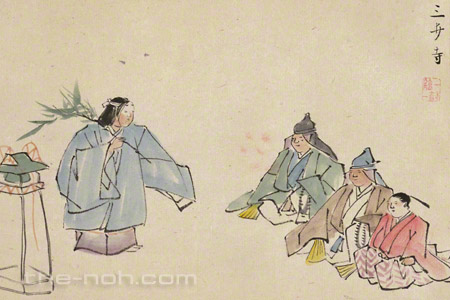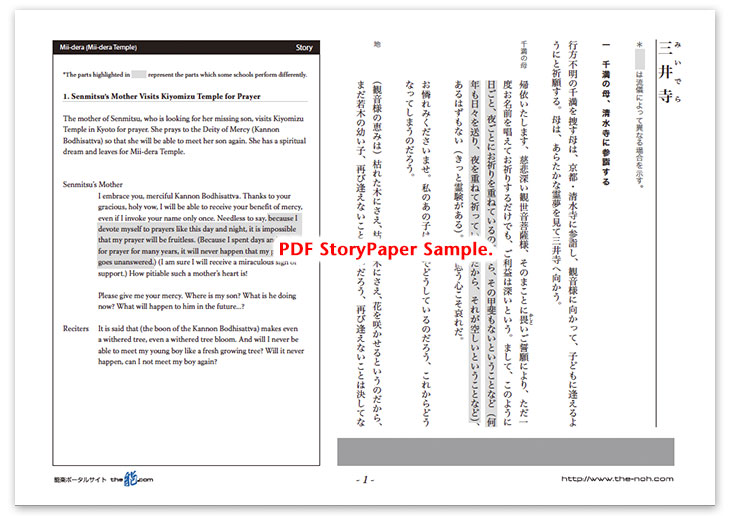
 Mii-dera (Mii-dera Temple)
Mii-dera (Mii-dera Temple)

![]()
In autumn, a woman who has come from Kiyomi-ga-seki in Suruga Province (around present-day Shizuoka Prefecture) devotedly prays to Kannon, the Deity of Mercy, at Kiyomizu Temple in Kyoto. She has traveled all the way to the capitol to make her prayers, motivated by her strong desire once again to meet with her son, Senmitsu, who has gone missing. The woman, dozing off between her prayers, has a spiritual dream. Thereupon, a passer-by who lives nearby the temple divines the dream, and judges that it instructs her to hurry to Mii-dera Temple in Ōmi Province (around present-day Shiga Prefecture) if she wants to meet with her son. The woman is delighted, and rushes to Mii-dera Temple.
At Mii-dera Temple the monks are ready to enjoy the Mid-Autumn Festival (in the lunar calendar), and are eagerly awaiting their viewing of the full moon. Among these monks there is Senmitsu, who has become a disciple of a monk residing in the temple. While the people are enjoying the beautiful harvest moon, Senmitsu’s mother, who has become a mad woman, appears. A temple servant, who has taken interest in the mad woman, invites her onto the temple grounds; ordinarily, women are prohibited there. The woman, amused by a peal of the temple bell, narrates the history of the bell at Mii-dera Temple; climbing up the bell tower, she starts to toll the bell. Again, the woman speaks about historical stories associated with bells in various temples, recites old poems, and preaches the Buddha’s Law, relating it with the bell and the moon.
Senmitsu, who feels something for the woman, inquires about the woman’s hometown through his master, and talks to her. The woman and Senmitsu recognize each other as mother and son and reunite in tears. The mother and son return home together and live a happy, wealthy life.
![]()
This is a masterpiece of Mad Woman stories, against the solid background of the bell and the moon. The first half of the drama develops in Kiyomizu Temple to describe the mother who departs to Mii-dera Temple in order to follow a divine message in her dream. Her properly upper-class origin is evident from her behavior, and at this point in time she has not gone mad yet. The story sets out smoothly.
The scene changes dramatically in the second half; a stage prop of the bell tower, which has a small hanging bell inside, is set on the stage. The drama describes the people in Mii-dera Temple on August 15 in the lunar calendar, the very night of the harvest moon. In the flamboyant atmosphere of the moon party, the poetic and dramatic story develops.
Appearing before the monks enjoying the moon party, a woman who holds a stick of a bamboo grass to show that she has become mad mounts the stage. She admires the view in the moonlight, even climbs up into the bell tower, tolls the bell, and tells stories associated with the bells in various temples. The stage prop of the bell tower shows its presence, and tasteful scenes, created with the elegant and flowing chorus and unique, quick and slow movements of the mad woman, are offered to the hearts of the audience (What is hidden behind these scenes is her parental tenderness; she is eager to stand out in the crowd by tolling the bell in order to gain any clue of the whereabouts of her son).
Needless to say, the bell and the moon are linked together in a play on words; a bell is tolled (tsuku in Japanese) while the moon is pronounced tsuki. A peal of the bell clearly traveling to the sky, and the clearly shining moon… The poetic sentiment colored by the bell and the moon creates the indescribable atmosphere of this drama. A bell "is tolled" ("tsuku" in Japanese) while the moon is pronounced.
STORY PAPER : Mii-dera (Mii-dera Temple)
Story Paper presents noh chant stories in modern speech, with story outlines, highlights and more using Adobe PDF format, which can print out and zoom in. Print out the pages and take them with you when you see the actual noh performance.

The copyright of Story Paper is held by the Noh.com. Story Paper is for individual use only. It is prohibited by the copyright law to distribute or publish printed-out Story Paper pages without prior consent. For more information, check the credit and disclaimer pages.



 [Mii-dera (Mii-dera Temple) : Story Paper PDF : 537KB
[Mii-dera (Mii-dera Temple) : Story Paper PDF : 537KB